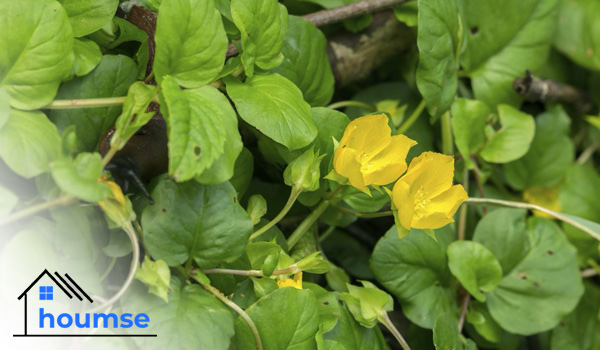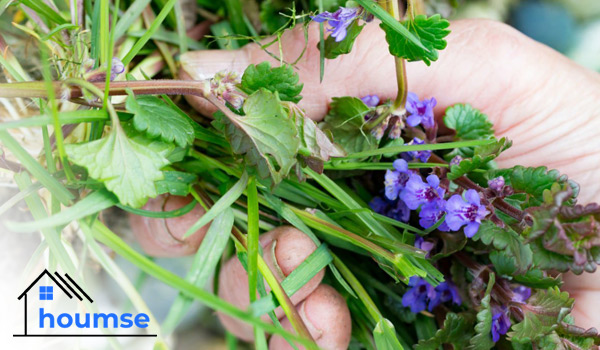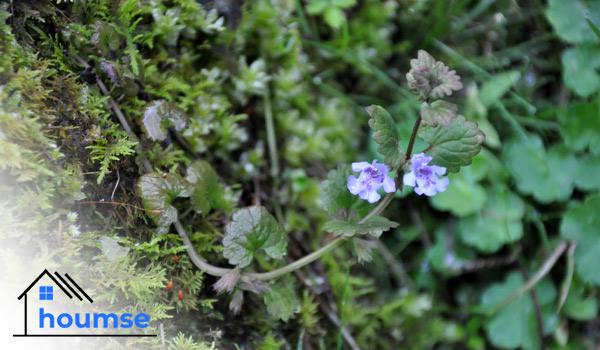How to Get Rid of Creeping Charlie? (4 Methods)

Creeping Charlie sounds like a possible case of a stalker neighbor across the street. But that is not what we are talking about. Creeping Charlie weed is a fast-spreading, weedy vine with round, scalloped leaves, and small, light blue flowers.
This weed also goes by several other names including “ground ivy”, “alehoof”, “gill-over-the-ground”, “catfoot”, “lawn ivy”, etc. No matter what you call it, this is an invasive plant. In fact, many gardeners believe that of all the lawn weeds a homeowner may have to deal with, Creeping Charlie is probably the worst perennial weed.
This is because it can take over your lawn or garden and make it difficult to control your landscape. As it grows, it can reach out and strangle other plants in its path. And it is especially hard to control if the Creeping Charlie plant gets into your flower bed or lawn.
Identifying the Glechoma Hederacea
This plant features square stems that can be from a few inches to 2 feet long with leaves’ that have a dark green to purple foliage. The plant has funnel-shaped flowers too. The Creeping Charlie flower is purple and spreads to form a dense mat close to the ground level.
Creeping Jenny vs Creeping Charlie
Many confuse Glechoma hederacea with Lysimachia nummularia, commonly known as the Creeping Jenny. Although both look alike at first glance.
But on closer inspection, you will notice Glechoma hederacea leaves, unlike Lysimachia nummularia, have scalloped edges. Additionally, Creeping Jenny flowers are yellow and not purple.

How to Get Rid of Creeping Charlie?
Although invasive, Creeping Charlie uses is a thing (or at least were). Throughout history, this low-growing herb has been used in everything from beer to salads to herbal medicines.
But it is not good in your garden. Controlling these sneaky plants can be a real challenge. But here are a few ways that can help you:
Method #1. How To Kill Creeping Charlie by Hand
What kills Creeping Charlie naturally? Simple, pulling them out with your hands.
This weed is a tough problem to solve because it spreads through seeds, roots, and stems. And simply mowing it just helps spread the grass. To get rid of it naturally, one of the best methods is to pull it out by hand after heavy rain or water the area until it soaks. This makes it easier to get the entire plant structure out, roots and all.
An intensive hand-pulling session should take care of most of it, but it is better to keep an eye on any smaller plants that appear in the coming weeks. Removing them immediately should be the solution. But make sure you do not leave any because even one Creeping Charlie weed rhizome can start a whole new attack on your garden.
Method #2: Maintain a Well-Fed Lawn
Creeping Charlie thrives on lawns that are poorly maintained, particularly those that are thin and lack nutrients.
So, when it comes to how to kill Creeping Charlie and control the situation, you must keep it from coming back, either by improving the density of the grass growing in that area or by planting something else that can outcompete it.
Experts suggest mowing the lawn regularly to a height of 2 to 3.5 inches as well as fertilizing, watering, and monitoring in the fall.

Method #3: Try Soil Solarization
Here is another answer to what kills Creeping Charlie naturally. This weed also thrives in shady, humid environments, such as under trees and bushes. Soil solarization is a pesticide-free process that burns weeds out of the soil using a concentrated amount of heat from the sun.
In hot, sunny months, soil solarization can be used to control the Creeping Charlie weed. Simply water the soil until it is moist, place a sheet of clear plastic (such as a plastic drop cloth used by painters) over the soil, bury the edges for safety, and let it sit for at least four weeks. After this time, remove dead weeds.
Method #4: Use Herbicides
If you are not keen on killing Creeping Charlie with natural methods, it is best to get rid of this plant in the spring or fall with a broadleaf weed killer containing triclopyr or dicamba. If the plants are too big to pull by hand, this may your best shot.
Such chemicals kill the weeds without harming your lawn. Experts claim fall (after the first frost) is the ideal time for this method, as weeds are actively growing, and the herbicide would reach the roots to target the entire plant.
You can go for a method that effectively removes everything in the area, though that means you will have to restart your lawn from scratch. Or you can selectively spray the Creeping Charlie weed with a lawn-safe product, following the manufacturer’s instructions.
However, the perfect time to treat your garden with herbicides depends on your climate, so be sure to contact your local agricultural extension office for more information. Pick a day when there is little wind and make sure there is no rain or snow within 24 hours of application.

Do Not Use These Methods to Kill Creeping Charlie
There are a lot of answers to the question of “how to kill Creeping Charlie” but not all of them are good ideas. To kill and prevent this annoying plant, do not use these methods:
Borax Solution
Do not bother with some DIY homemade potions. A common remedy for Glechoma hederacea is the Borax solution, but some experts advise against this because Borax can seep into the soil and damage the lawn as well as other plants.
If you use scientific precision in the mixing and application of the solution to kill Creeping Charlie weed, go ahead. Otherwise, you can end up with a case of Borax toxicity in the soil.
Killing Creeping Charlie with Vinegar
You can kill ground ivy with a solution of vinegar and warm water. However, it is not the best or most environmentally friendly. It does not kill the roots and it is not even the easiest method out there!
Vinegar contains acetic acid, which dries leaves out on contact. However, this substance is neutralized in contact with soil. And that is why vinegar does not kill the Creeping Charlie flower to the root. Vinegar is non-selective too, meaning it will attack any other plants near the invasive Glechoma hederacea.
Have you had any experiences with Creeping Charlie and its look alikes? What method helped you kill this weed? Let us know in the comments.
- In this post:
- Identifying the Glechoma Hederacea
- How to Get Rid of Creeping Charlie?
- Do Not Use These Methods to Kill Creeping Charlie



